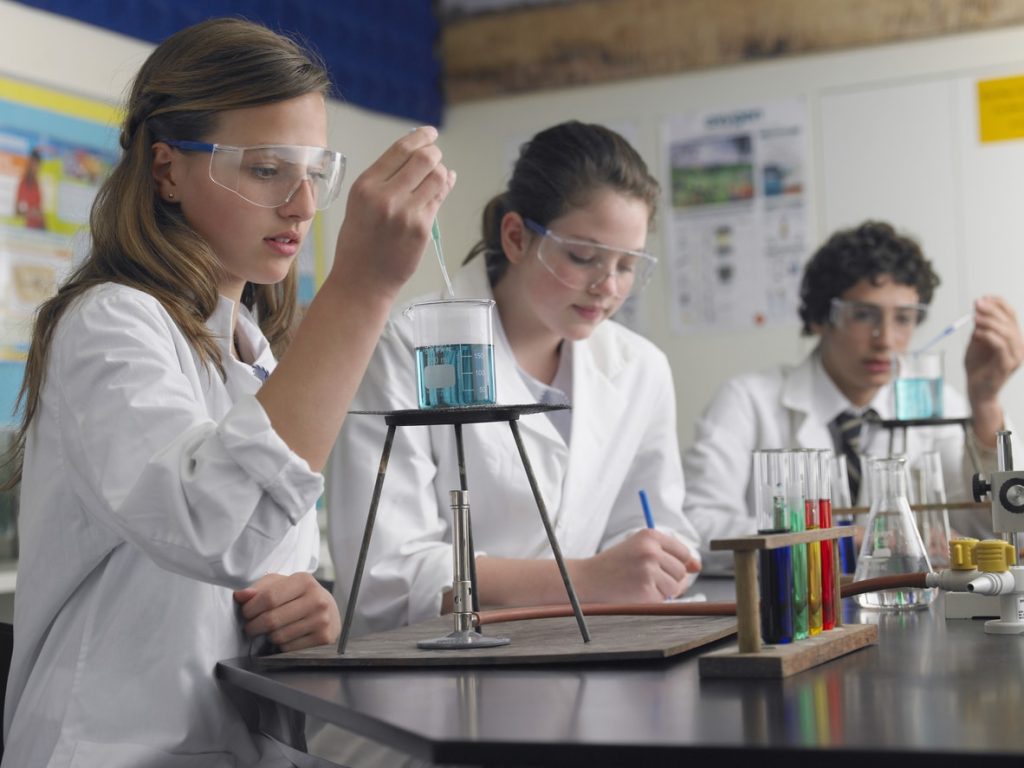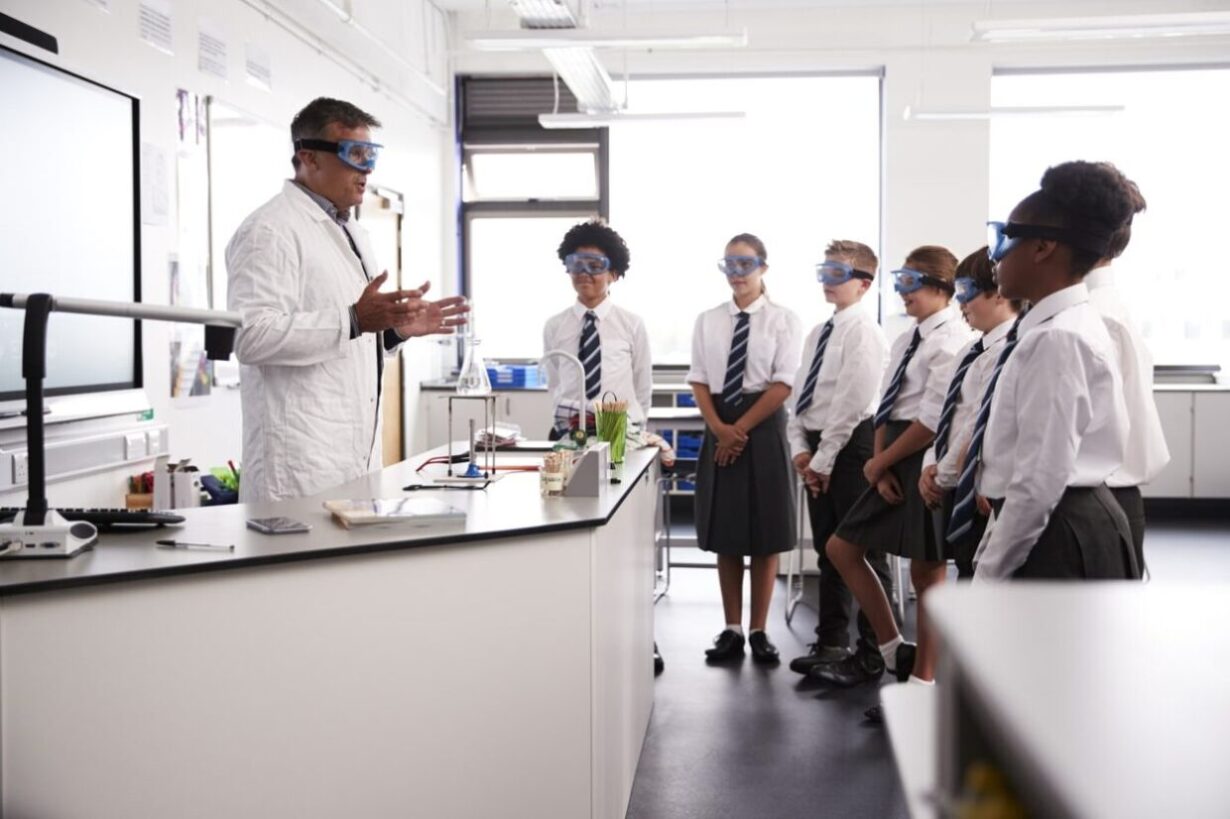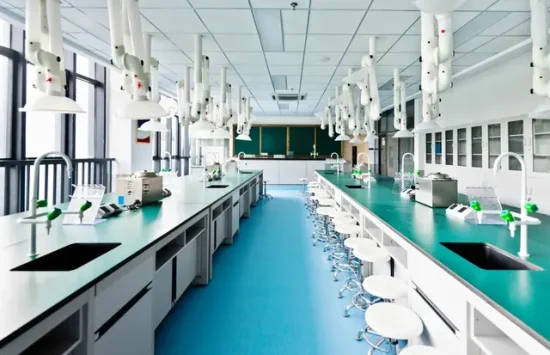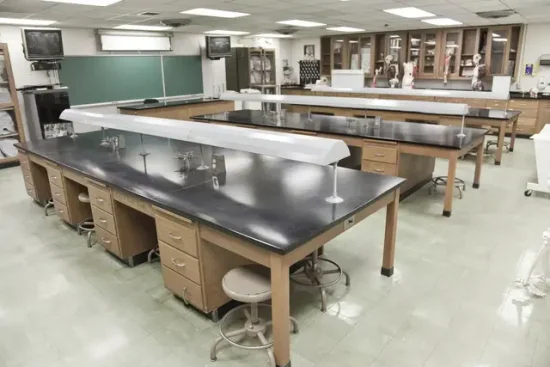Despite advancing technologies and evolving curricula, classroom design and layout has remained largely the same throughout the 20th century, right through to the modern day.
But research indicates that progressive classroom layouts can benefit student engagement in all subjects – and none more so than science.
Here, we’ll take a look at how the design and layout of school science labs can be optimised in order to improve the student learning and the effectiveness of teaching methods.
Greater lines of communication
When you think of the standard classroom setup, you’re probably picturing a teacher or course leader standing in front of row after row of students.
It’s practically a time-honoured tradition at this point, but such a set up can compromise effective lines of communication in the classroom. It certainly makes sense: only the front rows of students have unobstructed views of the teacher, while all the other rows are compromised. This can complicate dialogue between teacher and students, leading to distractions, misunderstandings and missed opportunities to learn.
More progressive classroom design can accommodate clearer views and lines of communication for the entire class. This ensures all students have the same opportunities to learn from their course leader, so that their education can progress more effectively.
Additionally, the more unobstructed the view, the less chance there is for students to misbehave and ignore their teacher.
Improved marriage of practical and theoretical learning
Unlike certain other subjects, science requires a combination of practical and theoretical learning.
Creating an environment which helps these two learning disciplines effortlessly complement one another can help students understand scientific principles. This also has the benefit of supporting both learning disciplines without compromising the other, which in turn can make learning more efficient and effective.
Optimal classroom laboratory design not only reduces the time spent moving between practical and theoretical learning tasks, but can also save significant space and budget too.
Environmental factors
Research by the University of Salford indicates that well-designed classrooms can help increase the academic progress of students by as much as 16%. Intelligent layouts and considered environmental factors can help more students fulfil their potential and retain increased levels of information.
Factors such as plentiful natural sunlight, positive and clear acoustics and even classroom colours can all help students fulfil their potential and increase academic progress. A well-conceived and considered classroom layout can allow all students equal access to these positive environmental factors.
Seamless implementation of technology
Since the launch of the first iPad in 2010, handheld technology and tablet devices have been increasingly used in classrooms and other learning environments. Many schools, such as Hove Park School in Sussex, have experienced an increase in student engagement since implementing iPads throughout classrooms.
The technology has proven effective in keeping students interested and engaged with their subjects and classes. Providing advanced learning tools and an endless wealth of knowledge, iPads and competing tablet devices can also help provide a more seamless transition between completing homework at home and working in the classroom.
Integrating these technologies into the layout and build of the classroom lets students reap the full range of benefits. That said, it’s important to ensure this technology is implemented in such a way that they are used as an educational aid, and not as a distraction.
Lighting matters
Your science lab’s location is another vastly important aspect of its design. Location can make all the difference, and somewhere that gets plenty of natural light can help students with experiments that require natural sunlight or an accurate understanding of colour and appearance.
But even before the experiments can begin, sufficient light can have a positive effect on learning, providing a soft, diffused quality that won’t go unnoticed. Simply put, if students can’t see what they’re supposed to, focus and attention is sure to take a knock.
You should take the lab’s location into account when considering its lighting. In north-facing labs, large windows can create more uniform lighting without glare. South-facing labs, on the other hand, would better suit smaller windows with blinds and external shading, striking a greater balance of natural light as it fluctuates through the day.
Meanwhile, east- and west-facing labs with larger windows can also keep glare to a minimum.
Improved storage and space
With all the apparatus and equipment needed to carry out practical experiments, your lab should have the requisite storage so that items are easily retrievable and won’t get in the way when not in use. Not only does this minimise set up times, but it also allows teachers to better plan for practical experiments throughout the academic year.
Likewise, you’ll need to factor in the students’ equipment too. Pupils tend to come with bags, coats and sports kits included, so making sure these added extras aren’t creating potential hazards on the floor is essential. Such items will need space so they can be properly stored away during the lesson.
The safety of students
Above all else, students’ safety is vital. A safe lab is one that can function efficiently and without distraction, so specific safety features must be built into its design.
Things like centralised on/off mechanisms, electronics and other hazardous experiments should be set up at certain areas so that the teacher or course leader can take action when it’s needed.
Got an upcoming construction project that needs completing? The team at InterFocus can help. For more information about our bespoke fitted labs, be sure to visit our homepage or call our team on 01223 894 833.[/vc_column_text][vc_column_text]Despite advancing technologies and evolving curricula, classroom design and layout has remained largely the same throughout the 20th century, right through to the modern day.
But research indicates that progressive classroom layouts can benefit student engagement in all subjects – and none more so than science.
Here, we’ll take a look at how the design and layout of school science labs can be optimised in order to improve the student learning and the effectiveness of teaching methods.
Greater lines of communication
When you think of the standard classroom setup, you’re probably picturing a teacher or course leader standing in front of row after row of students.
It’s practically a time-honoured tradition at this point, but such a set up can compromise effective lines of communication in the classroom. It certainly makes sense: only the front rows of students have unobstructed views of the teacher, while all the other rows are compromised. This can complicate dialogue between teacher and students, leading to distractions, misunderstandings and missed opportunities to learn.
More progressive classroom design can accommodate clearer views and lines of communication for the entire class. This ensures all students have the same opportunities to learn from their course leader, so that their education can progress more effectively.
Additionally, the more unobstructed the view, the less chance there is for students to misbehave and ignore their teacher.
Improved marriage of practical and theoretical learning
Unlike certain other subjects, science requires a combination of practical and theoretical learning.
Creating an environment which helps these two learning disciplines effortlessly complement one another can help students understand scientific principles. This also has the benefit of supporting both learning disciplines without compromising the other, which in turn can make learning more efficient and effective.
Optimal classroom laboratory design not only reduces the time spent moving between practical and theoretical learning tasks, but can also save significant space and budget too.
Environmental factors
Research by the University of Salford indicates that well-designed classrooms can help increase the academic progress of students by as much as 16%. Intelligent layouts and considered environmental factors can help more students fulfil their potential and retain increased levels of information.
Factors such as plentiful natural sunlight, positive and clear acoustics and even classroom colours can all help students fulfil their potential and increase academic progress. A well-conceived and considered classroom layout can allow all students equal access to these positive environmental factors.
Seamless implementation of technology
Since the launch of the first iPad in 2010, handheld technology and tablet devices have been increasingly used in classrooms and other learning environments. Many schools, such as Hove Park School in Sussex, have experienced an increase in student engagement since implementing iPads throughout classrooms.
The technology has proven effective in keeping students interested and engaged with their subjects and classes. Providing advanced learning tools and an endless wealth of knowledge, iPads and competing tablet devices can also help provide a more seamless transition between completing homework at home and working in the classroom.
Integrating these technologies into the layout and build of the classroom lets students reap the full range of benefits. That said, it’s important to ensure this technology is implemented in such a way that they are used as an educational aid, and not as a distraction.
Lighting matters
Your science lab’s location is another vastly important aspect of its design. Location can make all the difference, and somewhere that gets plenty of natural light can help students with experiments that require natural sunlight or an accurate understanding of colour and appearance.
But even before the experiments can begin, sufficient light can have a positive effect on learning, providing a soft, diffused quality that won’t go unnoticed. Simply put, if students can’t see what they’re supposed to, focus and attention is sure to take a knock.
You should take the lab’s location into account when considering its lighting. In north-facing labs, large windows can create more uniform lighting without glare. South-facing labs, on the other hand, would better suit smaller windows with blinds and external shading, striking a greater balance of natural light as it fluctuates through the day.
Meanwhile, east- and west-facing labs with larger windows can also keep glare to a minimum.
Improved storage and space
With all the apparatus and equipment needed to carry out practical experiments, your lab should have the requisite storage so that items are easily retrievable and won’t get in the way when not in use. Not only does this minimise set up times, but it also allows teachers to better plan for practical experiments throughout the academic year.
Likewise, you’ll need to factor in the students’ equipment too. Pupils tend to come with bags, coats and sports kits included, so making sure these added extras aren’t creating potential hazards on the floor is essential. Such items will need space so they can be properly stored away during the lesson.
The safety of students
Above all else, students’ safety is vital. A safe lab is one that can function efficiently and without distraction, so specific safety features must be built into its design.
Things like centralised on/off mechanisms, electronics and other hazardous experiments should be set up at certain areas so that the teacher or course leader can take action when it’s needed.
Got an upcoming construction project that needs completing? The team at InterFocus can help. For more information about our bespoke fitted labs, be sure to visit our homepage or call our team on 01223 894 833.








